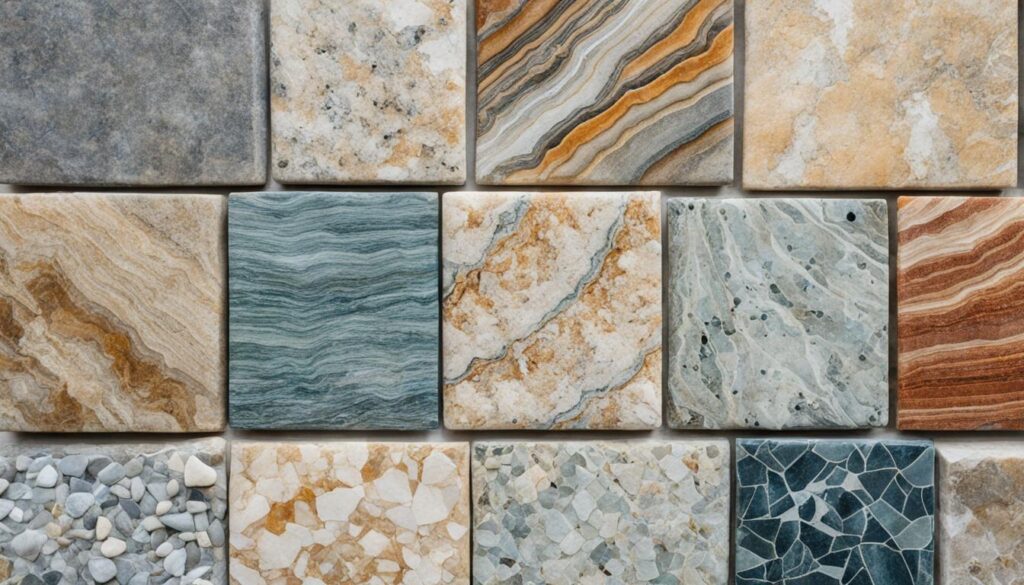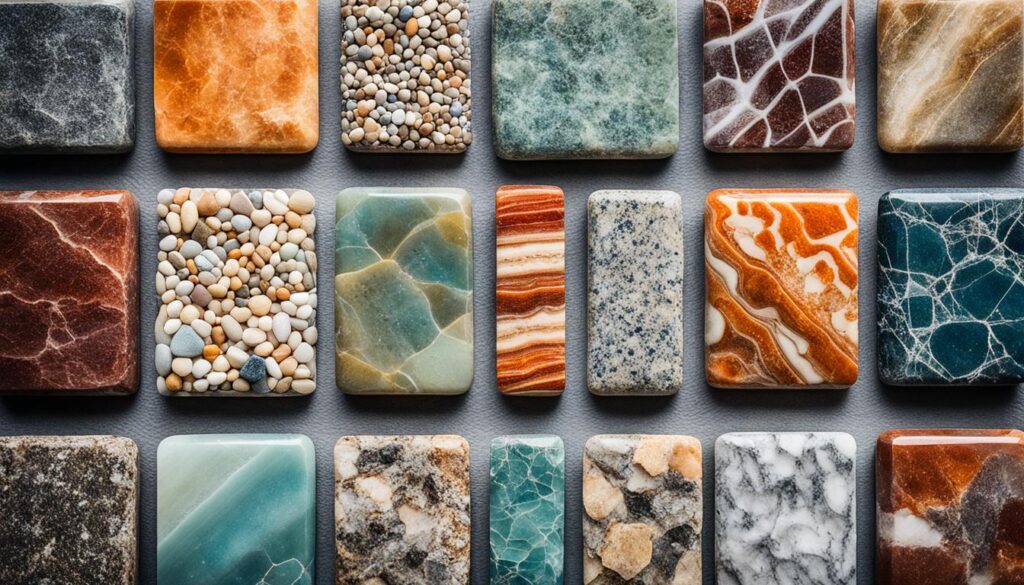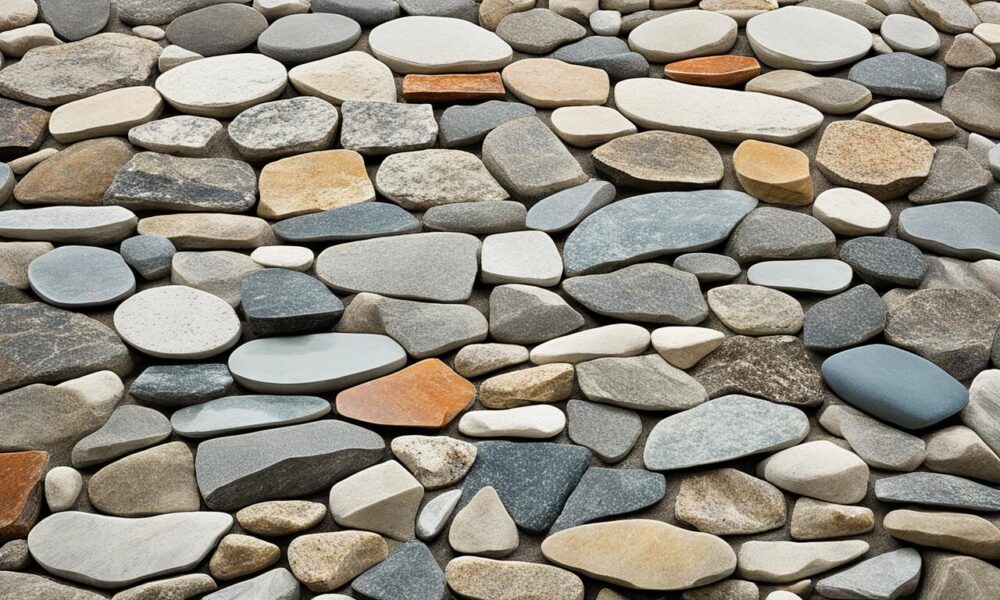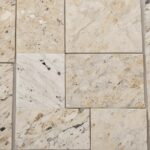Selecting Natural Stone: Your Essential Guide
Choosing the right natural stone is both an art and a science. It combines a love for Earth’s timeless gifts with smart design decisions. Every piece of natural stone is one-of-a-kind, much like your fingerprint. It displays a mix of patterns, colors, and textures that have developed over many years. This unique diversity brings out the beauty and increases the value of any home design project. Picking the correct stone is key to getting the look and usefulness you want.
Using natural stone in your home brings luxury and style. It also continues a long history of this strong and lovely material. If marble’s grand look, granite’s strength, or limestone’s gentle beauty draws you, knowing each stone’s special qualities helps you choose wisely. Marble & Granite Supply of Illinois, Inc. (MGSI) has many options like Marble, Granite, Onyx, Limestone, Travertine, and Soapstone. They are all shown in their large showroom1. The company provides expert advice and helpful tips. They assist homeowners and designers in making stunning and lasting spaces.
Key Takeaways
- Natural stone selection enhances the beauty and value of home design projects.
- Each natural stone piece is unique, similar to a fingerprint.
- MGSI showcases a wide variety of natural stones including Marble, Granite, and Limestone1.
- Proper stone selection can bring both luxury and resilience to any space.
- Understanding the properties of different stones ensures the best choice for specific projects.
Introduction to Natural Stone
Natural stone is known for its unique beauty and variations. It forms over millions of years through natural processes. You can find sedimentary, metamorphic, and igneous types, each with its own look and makeup.
What is Natural Stone?
Natural stone comes in many forms like limestone, granite, and marble. Sedimentary stones such as limestone are made mostly of calcium carbonate. This makes them varied in porosity. Sandstone, for example, resists acid etching and discoloration due to its quartzitic sand2. Marble and quartzite are metamorphic, changing under heat and pressure. They vary in acid resistance2. Granite, an igneous stone, is famous for its uniformity and durability2.
Benefits of Using Natural Stone in Home Design
Natural stone brings beauty and durability to home designs. It’s great for countertops, floors, and more3. Granite stands out for being tough and versatile, indoors or out4. Marble offers elegance and a variety of colors for kitchens and bathrooms4. Stone surfaces gain a natural patina, adding to their appeal over time2. Plus, using natural stone is eco-friendly, supporting green design.
Popular Trends in Using Natural Stones
There’s a growing trend of using natural stone in high-use areas. Stones like granite and slate are perfect for hallways and kitchens4. For outdoor spots like patios, choose stones that are weather and slip-resistant, such as granite or quartzite4. Using natural stone is also eco-conscious. When picking stone for your project, think about looks and longevity2. Testing samples and learning how the stone ages can help you decide2.
Understanding the Characteristics of Natural Stone
Natural stone has lots of features that make it special. Each feature brings beauty and function to your work. Knowing these will help you pick the best stone for your project and give you good tips.
Color Variation
The colors in natural stone depend on what it’s made of and how it was formed. Granite has a variety of beautiful patterns and colors. It’s perfect for busy places like kitchens56. Marble, on the other hand, offers soft shades. It adds elegance to bathrooms56.
Veining
Varying minerals create veining in natural stone. This makes the stone look luxurious and attractive. Marble, especially from Persia, has beautiful veins. Quartzite is also known for its nice veining and is very tough56.
Pitting
Travertine often shows pitting, which are small holes or dips. This adds charm but means more care is needed. Limestone is softer and gets pits more easily. It needs gentle care and maintenance5.
Finishes and Their Effects
Finishes change how natural stone looks and its care needs. There are many finishes like honed, polished, sandblasted, and thermal. A polished finish makes the stone shiny but can show scratches. A honed finish gives a matte look that hides scratches better. Sandblasted and thermal finishes make the stone textured. This is good for slip resistance in wet places7.

Maintenance Requirements
Different stones and finishes need different care. Granite is very tough and easy to look after, great for kitchens5. Marble is softer and needs more care, good for places that aren’t too busy5. Quartzite is super tough and good for many uses. It’s important to choose the right care products to keep your stone project looking good56.
A Guide to Choosing the Right Natural Stone for Your Project
Choosing the right stone is a skill. It means knowing about different stones, their traits, and how they handle various conditions. This guide provides key insights to help you pick natural stones. Your projects will look great and last long.
Types of Natural Stones: Sedimentary, Metamorphic, and Igneous
Natural stones fall into three categories: sedimentary, metamorphic, and igneous. Sedimentary stones like limestone form from minerals and organic matter. They’re great for outdoors8. Metamorphic stones change under heat and pressure. They’re known for their patterns and toughness, perfect for indoor use89. Igneous stones come from cooled lava. Granite, for example, withstands a lot, making it ideal for busy places9.

Considering Stone Hardness and Durability
It’s crucial to think about stone hardness and durability for your projects. Stones like granite are very hard, resisting scratches well. They’re great for kitchens and busy floors89. Slate offers a unique texture and is slip-resistant, an excellent choice for flooring8. Marble adds luxury but needs more care, fitting less busy areas well8.
Reactivity to Oils and Acids
Stones react differently to oils and acids based on their porosity. Granite and quartz are low-maintenance, fighting off stains in busy kitchens8. But limestone and marble are more porous. They need regular sealing to stay beautiful and stain-free8.
How Weather and Climate Affect Stone Performance
Weather and climate play a big role in how stones perform. Granite and sandstone do well outside, even in tough climates. They resist UV rays and moisture well89. Granite also handles freeze-thaw cycles, staying strong in changing weather9. Marble, though, might lose color in constant sun, needing UV protection to keep its color9.
| Type | Properties | Ideal Applications |
|---|---|---|
| Granite | Durable, non-porous, heat-resistant | Countertops, flooring, outdoor spaces |
| Marble | Luxurious, elegant veining, porous | Vanities, walls, low-traffic areas |
| Limestone | Natural, earthy appearance, consistent under pressure | Flooring, wall cladding, outdoor paving |
| Slate | Durable, unique cleft texture, slip-resistant | Roofing, flooring, walkways |
| Sandstone | Rich, warm tones, porous | Patios, garden paths, landscape features |
Things to Consider When Choosing Natural Stone
Choosing natural stone for your project needs careful thought. You must consider several things to make sure the end result fits your design dreams and life needs.
Style and Aesthetic Considerations
Make sure the stone matches your space’s style and decor. Granite brings a rustic feel, perfect for farmhouse kitchens and cozy areas10. Quartz, however, fits sleek, modern designs well10.
Choosing the Right Color and Texture
Color and texture are key to a room’s look. Granite offers various colors and patterns, adding an earthy vibe11. Marble, known for its elegance and luxury, features beautiful veining10. Pick the right stone to match your vision.
Understanding Your Stone Samples
Getting stone samples is crucial. Every slab is unique, showing different patterns and colors12. View samples in your space and check their durability.
Granite and quartzite are tough, perfect for busy areas10. Marble, though, needs more care10.
Budgeting for Natural Stone Projects
Budget is important in choosing natural stone. Marble is often seen as budget-friendly11. But consider long-term costs. Granite needs annual resealing11. Engineered quartz, though, needs little upkeep and is durable10.
Practical Tips from Design Specialists
When choosing stone for a project, listen to experts. Granite is great for many areas because it’s affordable and stylish1314. Marble adds an elegant look everywhere13. Travertine, with its textured finish, is perfect for various spaces, offering over 100 choices at Attila1314.
The climate plays a big role in picking stones like limestone and soapstone. Limestone is tough and good both inside and outside13. Soapstone resists heat, great for kitchens and fireplaces13. Dolomite works well around pools and for entertaining outside14.
To keep your stone looking good, regular maintenance is key. Seal granite to avoid stains13. Working with reputable suppliers like Attila ensures you get top-quality stone from Europe14. Their 25 years of experience means they’re reliable for any stone project14.
Budgeting wisely is crucial. Know the costs for stone, setup, and upkeep. Granite is affordable and durable14. Choosing smartly and working with experienced suppliers will help you create a beautiful, lasting design.
| Stone Type | Key Benefits | Recommended Applications |
|---|---|---|
| Granite | Affordability, unique styles, durability | Countertops, floors, home surfaces |
| Marble | Elegance, timeless appeal | Indoor and outdoor applications |
| Travertine | Textured finish, variety | Floors, walls, countertops |
| Limestone | Durability, stain resistance | Indoor and outdoor uses |
| Soapstone | Heat resistance | Countertops, fireplaces, outdoor kitchens |
| Dolomite | Reliability, suitable for outdoor areas | Poolside, outdoor entertaining areas |
Conclusion
Starting a project with natural stone can be very exciting and a bit complex. You can choose from options like durable granite or elegant marble that needs careful sealing in less used areas15. Whether you prefer granite for busy spots or limestone for quieter areas, picking the right stone is crucial15.
Natural stone brings beauty and practical benefits to any space. For example, slate is great for floors, roofs, and outside walls because it resists stains and slips15. When choosing stone, think about the cost of getting it and how it needs to be maintained. For more tips, check out this detailed guide.
Using natural stone in your project can make it timeless. Following these tips and getting advice from experts will help you start confidently. Choosing natural stone is about more than looks; it’s about making something beautiful and lasting.
FAQ
What is Natural Stone?
What are the Benefits of Using Natural Stone in Home Design?
What are the Popular Trends in Using Natural Stones?
What Influences the Color Variation in Natural Stone?
How Does Veining Occur in Natural Stone?
What is Pitting, and How is it Addressed?
What are Different Stone Finishes, and How Do They Affect Appearance?
What Should be Considered Regarding Natural Stone Maintenance?
What are the Main Categories of Natural Stones?
How Does the Mohs Scale of Hardness Influence Stone Selection?
How Does Stone Reactivity to Oils and Acids Impact Selection?
How Does Climate Affect Natural Stone Performance?
Why is it Important to Align Stone Selection with Style and Architecture?
What Should One Consider When Choosing Color and Texture of Stone?
Why is Testing Stone Samples Crucial?
How Should One Budget for a Natural Stone Project?
What are Some Practical Tips from Design Specialists?
Source Links
- SELECTING THE RIGHT TYPE OF NATURAL STONE FOR YOUR PROJECT
- A quick guide to natural stone and how to choose the right one
- What is Natural Stone? A Comprehensive Guide
- Guide For Selecting Natural Stones For Your Home – Fair Deal Marbles & Granite
- How to Choose the Right Natural Stone for Your Home – Rock Doctor
- The Ultimate Guide to Choosing the Right Natural Stone for Your Project – CASTLEKING
- TC Natural Stone | Homeowner Guide | Natural Stone Outside Idea
- 10 Tips on choosing the Right Natural Stone for Your Project
- A Comprehensive Guide To Selecting The Perfect Natural Stone For Your Construction Project
- How to Choose the Right Stone for Your Project | Stone Surface INC
- How to Choose the Right Natural Stone
- 5 Things to Consider When Choosing Natural Stone – BC Stone
- How to Choose the Perfect Natural Stone for Your Home: 7 Tips from Design Specialists – Carmel Stone Imports
- Natural stone selection | Which stone is best for your next project?
- How to Select the Right Natural Stone for Your Project



